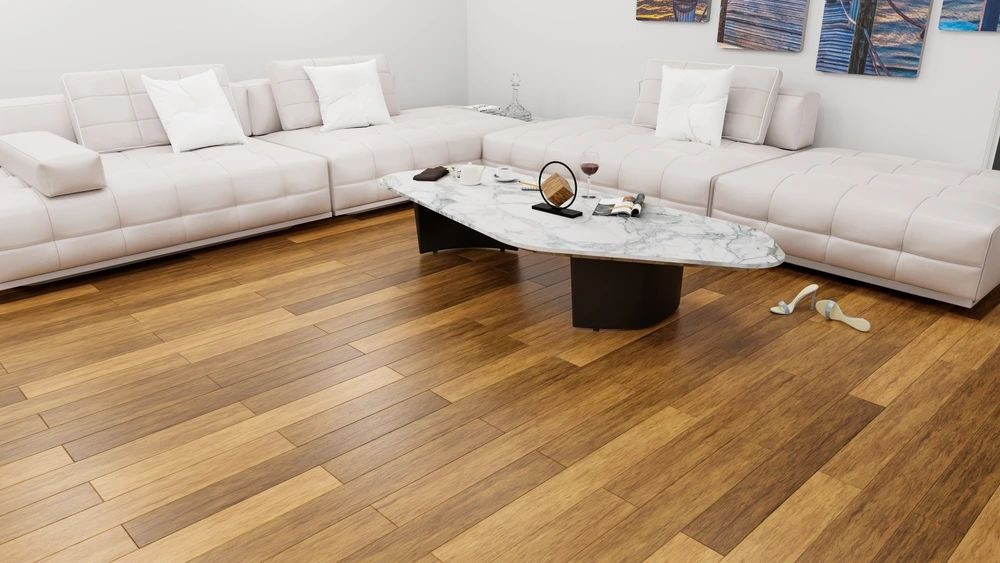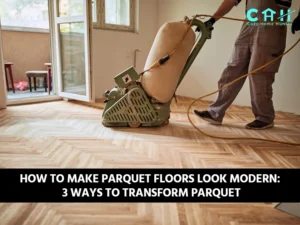Engineered hardwood floor is, without a doubt, an excellent hardwood alternative and one of the best flooring options overall. Engineered hardwood is durable, more affordable and water-resistant than solid hardwood — and it works pretty much in any area.
If one of the many upsides of engineered hardwood has already persuaded you to install them in your home, you need to know how to clean engineered hardwood floors without damaging them. Because otherwise, you can actually damage your floor in the cleaning process.
So, how to clean engineered hardwood floors? What are some of the most common engineered hardwood floor cleaning mistakes? Let’s discuss.
Table of Contents
How to Clean Engineered Hardwood Floors

Step 1: Sweep or vacuum the floor thoroughly
Dirt and grime build-up can be a major hurdle to cleaning wooden surfaces. Keeping dirt and debris off the floor is key. Dust particles act like sandpaper when you step on them and scratch the surface. They can also get into the top layer of textured hardwood and damage them. It is recommended to sweep or vacuum high-traffic areas daily. You can also run your Roomba in busy areas like the kitchen, dining area, family living, etc. You can run the vacuum or sweep in fewer traffic areas once or twice a week.
After the daily sweep using a broom, you can use a dry mop or dust mop to pick up any remaining dirt if you are not going to follow up with mopping. You can also run dry (microfiber cloths) to clean up the fine dust that the broom hasn’t picked up. Make sure you use a soft-bristled broom and, of course, move with the grain when cleaning. Use the hard floor setting on your vacuum to avoid scratching the wood with the brush roll.
If you don’t want to go through the repetitive process of vacuuming or brooming the floor and following up with a dry mop, the Swiffer Sweep + Vac is an incredible tool. It cleans and sweeps simultaneously to remove all the dust and debris from the engineered hardwood floor. It also keeps your floor cleaner in between mops.
Step 2: Choose the right cleaning products
Before moving on to the mopping part, let’s discuss which products are safe to use on engineered hardwood floors. The top layer of engineered hardwood consists of a thin layer of hardwood. So, a good quality hardwood cleaner is also safe to use on engineered hardwood flooring. We cannot stress this enough, but using the right cleaning product is key to a squeaky clean floor. Keep in mind that different finishes require different products. So, ask your manufacturer to find out which type of finish you have and find a suitable product.
Experts recommend avoiding harsh chemicals to clean any hardwood floors as they can create hazing. Also, avoid anything that says it will polish, shine, rejuvenate, or revitalize the wood floor. These will only create unnecessary product build-up when used too often and make the wooden floors look cloudy after a few months. Avoid using straight ammonia, alkaline products, or abrasive cleaners, as they dull and damage the surface.
You can use something as simple as a few drops of Murphy Oil Soap diluted in warm water to mop your engineered hardwood floor. Another great DIY alternative is a cap full of vinegar and a few drops of dish soap (half a pinky nail worth) mixed in with a bucket of warm water. Vinegar is a mild disinfectant and cuts through grease and grime without leaving any streaks. Use warm water instead of cold water, as it dries up quickly.
Step 3: Prepare the area
Before moving on to mopping, remove any portable object from the floor that will make it challenging for you to clean the floor. Remember that the more edges and corners you have around the room, the higher the chances of debris getting stuck. Remove the furniture if possible. Lastly, block the house entrances to prevent children or pets from stepping on the damp floor.
Step 4: Use a damp mop to clean the floor
For the best mopping result on your wood floor, keep five key things in mind –
- Use a damp mop, not wet
- Use a flat microfiber mop or microfiber twist mop
- Mop in an “S” pattern
- Dry the floor quickly by either using a ceiling fan or microfiber cloth
- Mop along the grain of the wood
Prepare your mopping solution and soak the mop head in the bucket for a few minutes to soften. Put the mop in the wringer and twist until almost dry. If you are using a flat head mop, slide it against the dryer at least 3 to 4 times. Start mopping from a corner using an “S” shaped pattern and sweep your way out of the room.
When mopping a large area, divide the floor into sections for the best result. To be extra diligent, you can take a microfiber cloth and do a quick wipe-down so no water is left behind. You can also turn on the ceiling fan to dry the floors. Change the water once it becomes dirty. A quick rule of thumb is to change the water once you can’t see the bottom of the bucket. Rinse and re-dampen the mop often to avoid streaks.
You should mop high-traffic areas at least once or twice a week. For less-trafficked floors, you can get away with cleaning once per month or once a season. Avoid mopping against the grain for the best results.
Step 5: Treat any scuffs or scratch
Regardless of how well you sweep or mop, you will find stains and scratches that the mop just won’t get rid of. The best way to get rid of stains and scuffs on engineered hardwood is to get on your hands and knees and treat them individually.
To remove any scuffs or stains, use a damp sponge and dish soap and gently rub the area. If it doesn’t remove the stain, apply some baking soda to the spot and rub it using a microfiber cloth. Remove all baking soda residue from the area and wipe it dry. Never use steel wool or hard bristled brushes on engineered hardwood since the topmost hardwood layer is very thin and will wear out from excess friction.
Engineered hardwood floors are prone to scratches, similar to solid hardwood floors. Use a liquid scratch concealer that forms a permanent seal when dry to reduce the appearance of the scratches. This seal will not come off when you mop next time. You can also use something as simple as stain markers to fix surface scratches.
Engineered Hardwood Floors Cleaning Mistakes
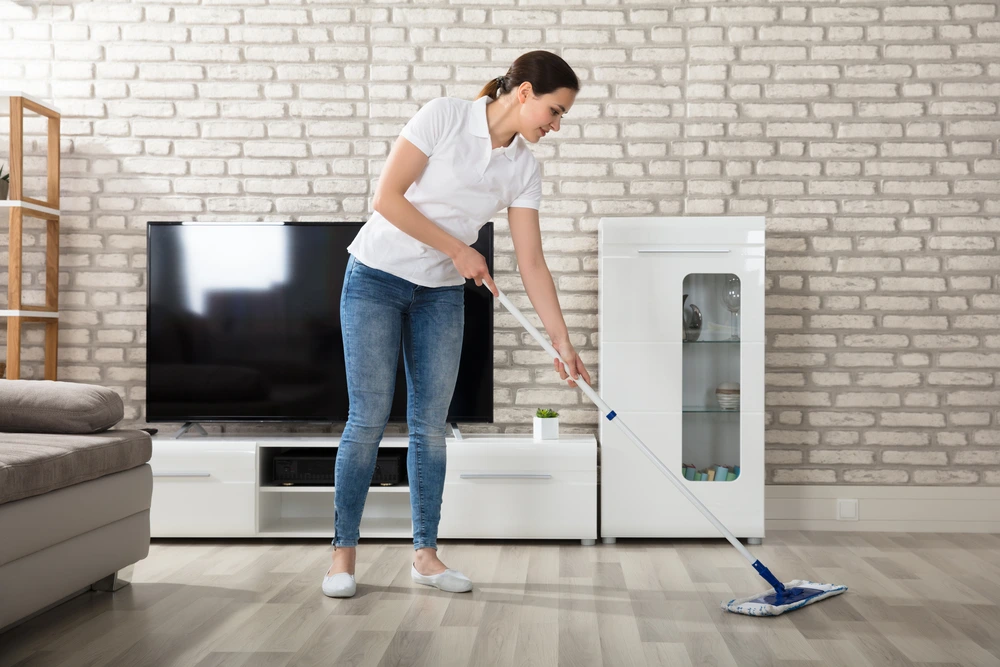
If you don’t know how to clean engineered hardwood floors, you can end up damaging your floors in the cleaning process. Knowing what not to do when cleaning engineered hardwood floors can save you from a hefty replacement bill in the future. Some common engineered hardwood floors cleaning mistakes are –
Using harsh chemicals
Avoid harsh chemicals to clean engineered hardwood floors as they can damage the hardwood surface. Avoid using straight ammonia, alkaline products, or abrasive cleaners, as they dull and damage the surface. Also, avoid anything that says it will polish, shine, rejuvenate, or revitalize the wood floor. These will only create unnecessary product build-up when used too often and make the wooden floors look cloudy after a few months.
Scrubbing with abrasive tools
The hardwood layer on engineered wood is very thin. Avoid using steel wool, scour pads, hard-bristled brushes or brooms to clean engineered hardwood floors. Use microfiber clothes to scrub any scuffs or scratches gently. Only use soft-bristled brooms to sweep the floor.
Steam mopping
Steam mopping can seep moisture between the wood planks. The excess water can damage the subfloor or the engineered hardwood itself. Even though engineered hardwood is more moisture-resistant than solid hardwood flooring, regular steam mopping can still warp it or damage the finish.
Mopping with excess water
A common misconception about engineered hardwood floor is that it is waterproof. While engineered wood is water-resistant to some degree, it is not waterproof. You should only mop engineered floors using a damp mop and rinse as much water as possible. You can also use a ceiling fan or wipe with a dry cloth to speed up the drying process.
Can You Wet Mop Engineered Hardwood Floors?
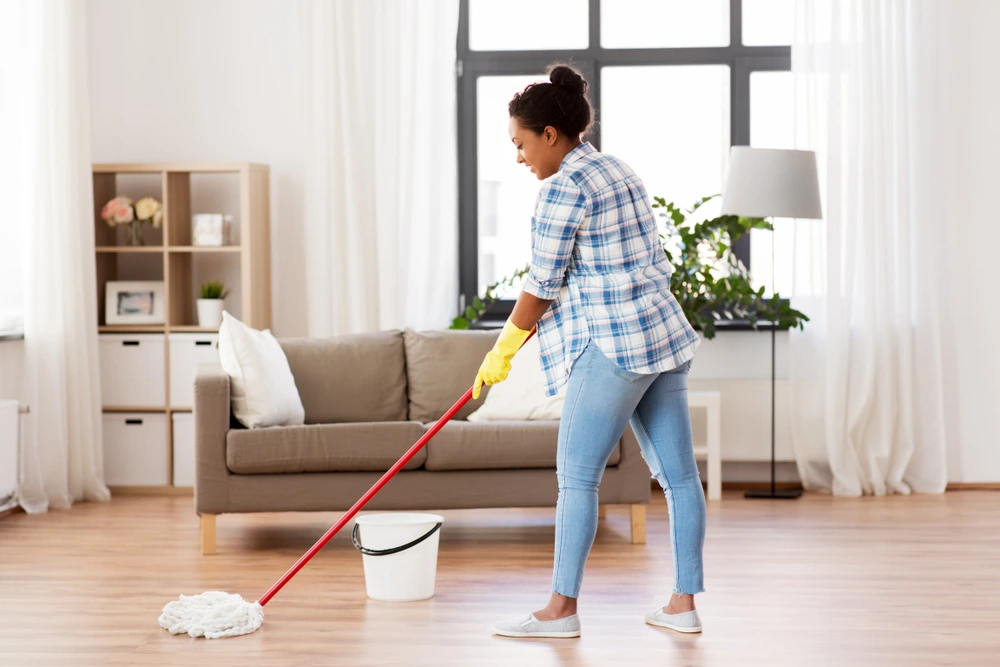
Engineered hardwood is more water resistant than solid hardwood, but it is not waterproof. Use a damp mop to clean engineered hardwood instead of a wet mop to avoid moisture seeping through the wood. Excessive water when mopping can also get in between the planks and rot it from below. There is also a risk of damaging the subfloor if moisture gets underneath the wood planks.
When mopping engineered hardwood floors, dry the mop thoroughly to make sure there is no excess water. You can also fan dry the floor or use a clean, dry cloth to dry the floor. Damp mops can get completely dry and stiff very quickly, so rinse them out often to re-dampen them.
What is the Best Cleaner for Engineered Hardwood Floors?
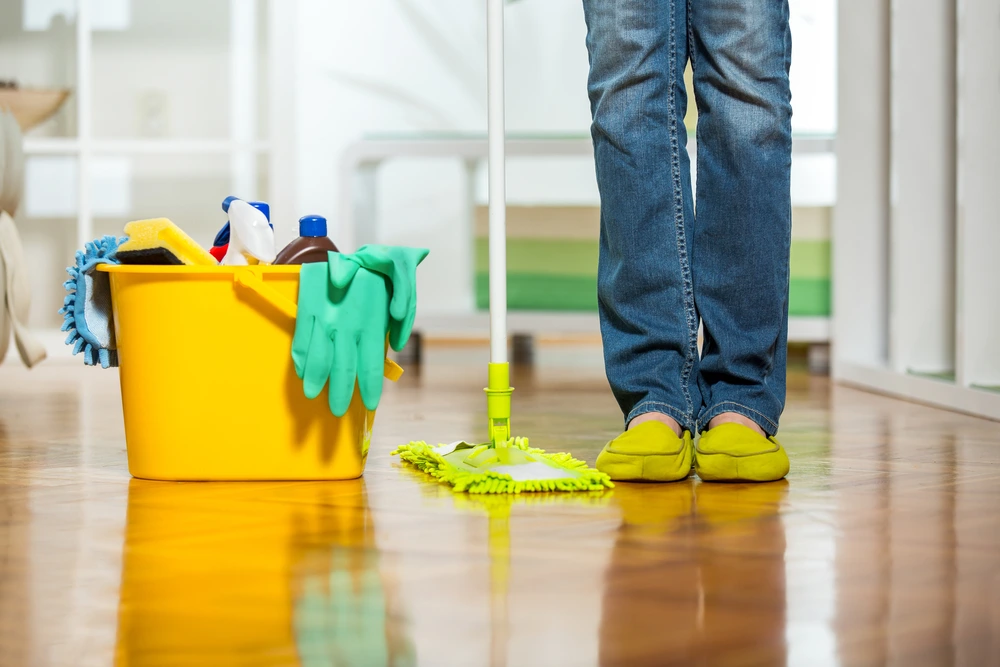
We cannot stress this enough, but using a safe and effective cleaner plays the most important role in cleaning engineered hardwood floors. So, we have put together a list of the five best cleaners for engineered hardwood floors.
Bona Hardwood Floor Cleaner Spray
Bona Hardwood Floor Cleaner is a high-quality wood floor cleaner that is well-rounded from all different aspects. It quickly removes sticky residues and shoe marks but is still gentle to the wood. The cleaner comes in a convenient spray bottle that you can use with any cleaning pads or microfiber clothes (recommended for best results). You can also use it with Bona’s own cleaning pads.
Murphy Oil Soap Concentrated Wood Cleaner
If you are on a budget, look no further than the classic Murphy Oil Soap. It is perfect for both deep cleaning and regular cleaning. It removes scuff marks and sticky residues while leaving the floor finish unharmed. You need to dilute the cleaner before you use it, making one bottle last a lot longer than other floor cleaners and adding to its affordability.
Better Life Naturally Dirt-Destroying Floor Cleaner
The Better Life Naturally Dirt-Destroying Floor Cleaner is safe, effective, affordable, easy to use, and leaves a streak-free finish. The natural blend of coconut, corn-based cleansers, and essential oils is a safer choice for households with pets and kids. It effectively removes grime and soil without using any harsh chemicals. You can simply squirt better life directly on your engineered hardwood to clean them; no additional rinsing is required.
Libman Hardwood Concentrated Floor Cleaner
Libman Hardwood Concentrated Floor Cleaner effectively dissolves sticky soil and scuff marks, leaving a streak-free finish. It can be diluted using water — so a little goes a long way. It comes with a built-in cup for mess-free measuring. Simply squeeze the bottle to fill the measuring cap with the recommended amount of cleaner and pour it directly into your mopping bucket. Libman also offers spray mops for hassle-free mopping.
Bona PowerPlus Hardwood Floor Deep Cleaner Spray
Bona PowerPlus Hardwood Floor Deep Cleaner Spray is definitely one of the best cleaners for deep cleaning engineered hardwood floors. It leaves a streak-free shine and deeply cleans the floor without damaging the delicate wood. It is certified by the EPA’s Safer Choice program and does not contain any ingredient that is harmful to you or the environment. Its oxygenated, fast-drying formula penetrates dirt, grime and heavy build-up on wooden floors. It comes in a convenient spray bottle that requires no extra diluting step. It is safe to use on all polyurethane-finished wood floors.
Do you have any tips and tricks for cleaning engineered hardwood floors? Comment below and let us know.

